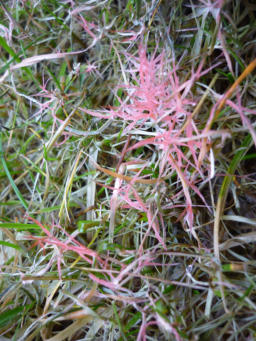
Red Thread



Ultralawn Incorporated
1055 East 260th Street
Euclid, OH 44132
216.731.7756
440.951.3738
Office hours Monday-Friday 9-3 call today with any questions

Symptoms: Lawns infected by red thread may have a pink-to-reddish cast
when viewed from a distance. If moist grass is viewed more closely, pinkish
growth and tiny cotton candy tufts of spores may be seen. In drier
conditions, tiny red threads of the red thread fungus may be seen
extending from the leaf tips. The grass itself may show irregular patches of
dead and dying leaves, giving the lawn a ragged appearance. These
diseases can be found on many turf grass species but are seen most often
on perennial ryegrasses and fine fescue. The diseases are restricted to the
leaves and are not usually very destructive. Both fungi occur mostly in the
spring and fall in cool 65-70 degree, moist weather.
Disease Cycle: The fungus survives in the thatch when dry. Some spores
or pieces of fungus may be airborne, but the fungi are commonly spread
by water, feet and mowing. Infections are most common on slow-growing
grass stressed by compaction, drought, low temperatures or inadequate
fertility.
Cultural Management: Although we have no control over periods of
prolonged cool, moist weather, it is possible to prevent or reduce red
thread through good lawn care practices. Watering should be infrequent
and deep. Avoid frequent sprinklings late in the day that extend the time that the grass blades stay wet. Soil
fertility must be balanced. These diseases are most common in nitrogen-deficient turf. If red thread is found in
slow growing grass, it may be helpful to temporarily collect clippings during mowing to reduce the amount of
fungus returned to the lawn. Aeration of compacted soil will improve turf growth and reduce these diseases.
Chemical Management: Fungicides are not necessary for red thread. Typically a light dose of fertilizer will help
the disease grow out and run its course; however, a fungicide application will help aid in a quicker recovery.

Notice the “thread like” strands developing of
the grass blade


















